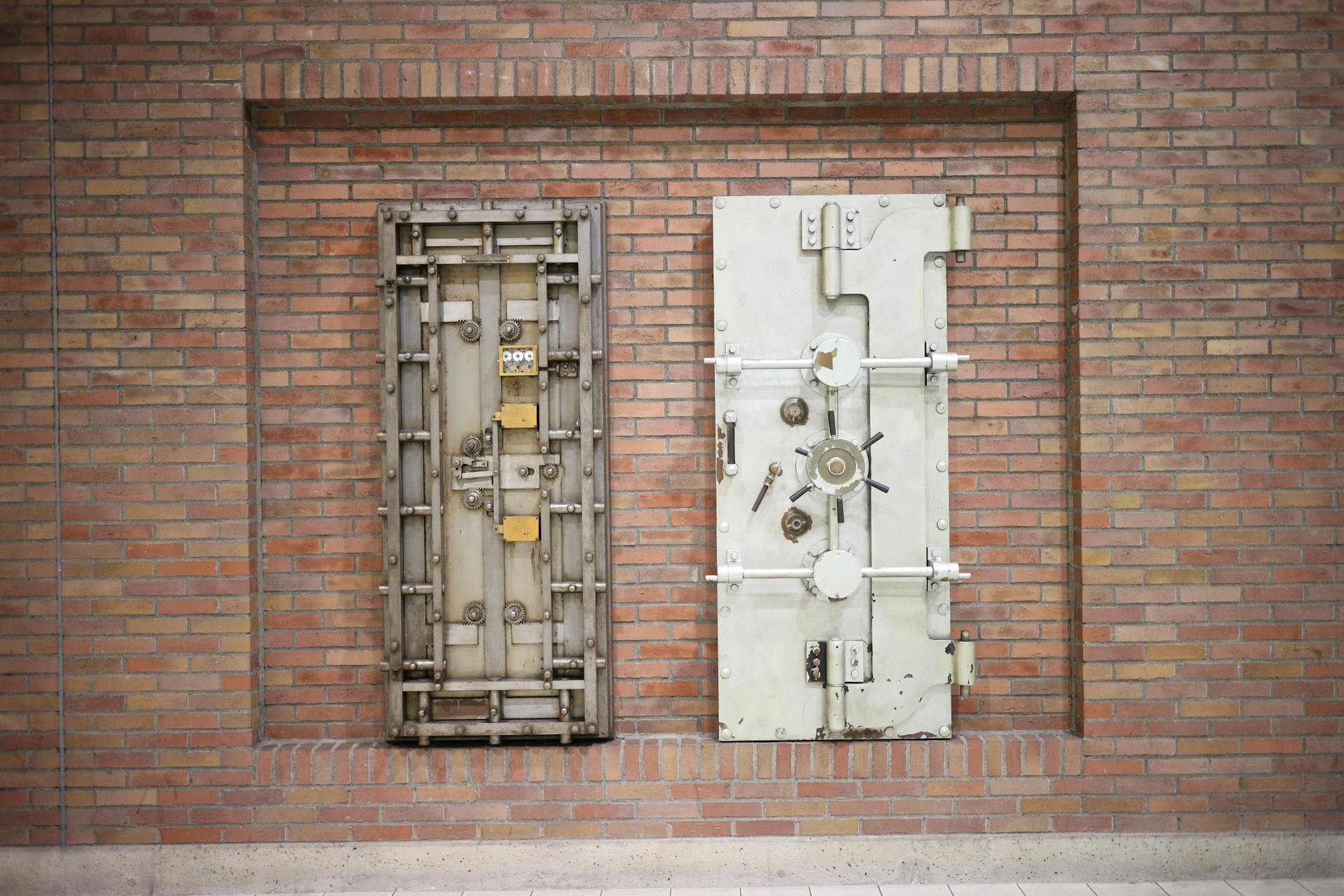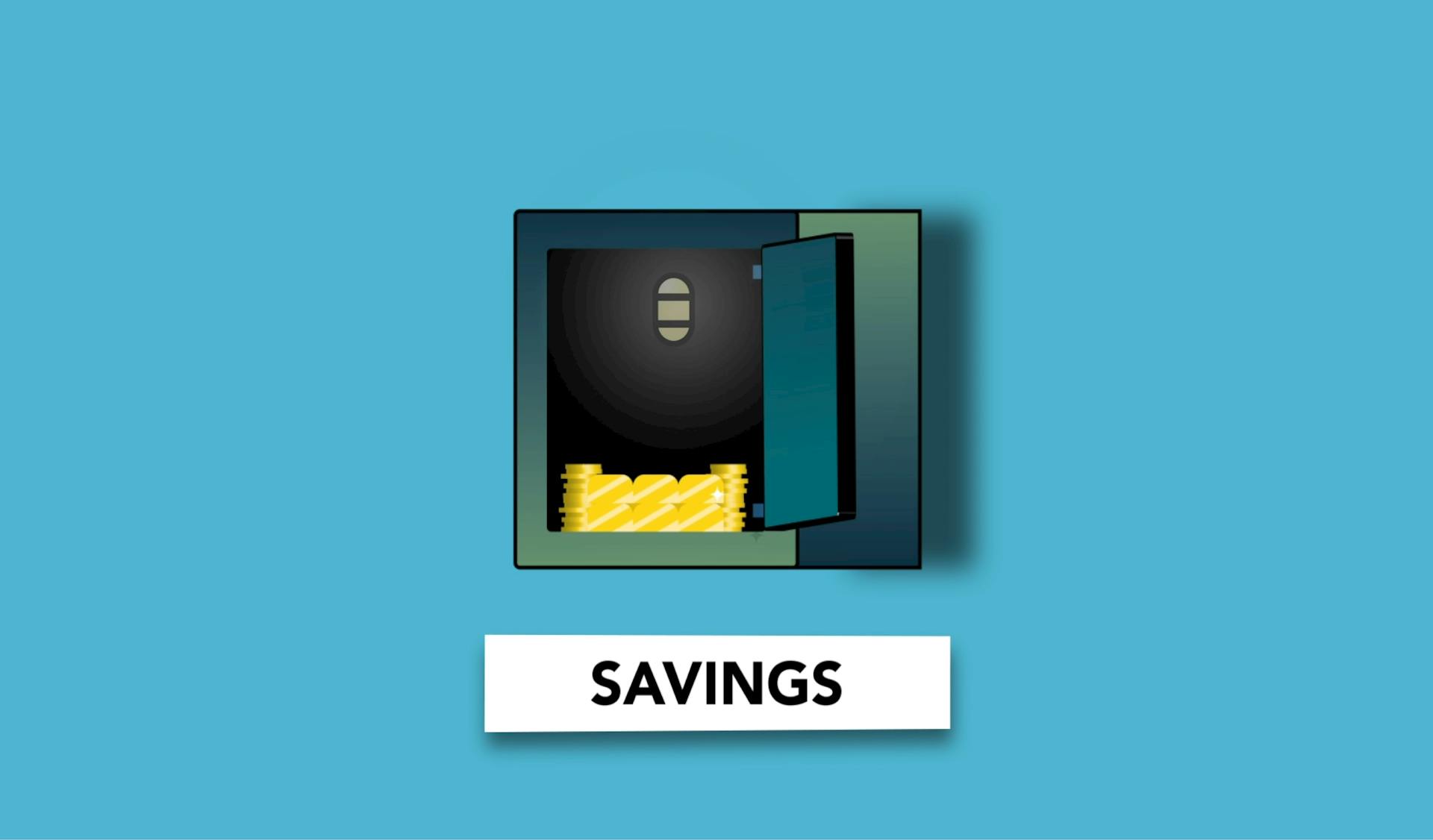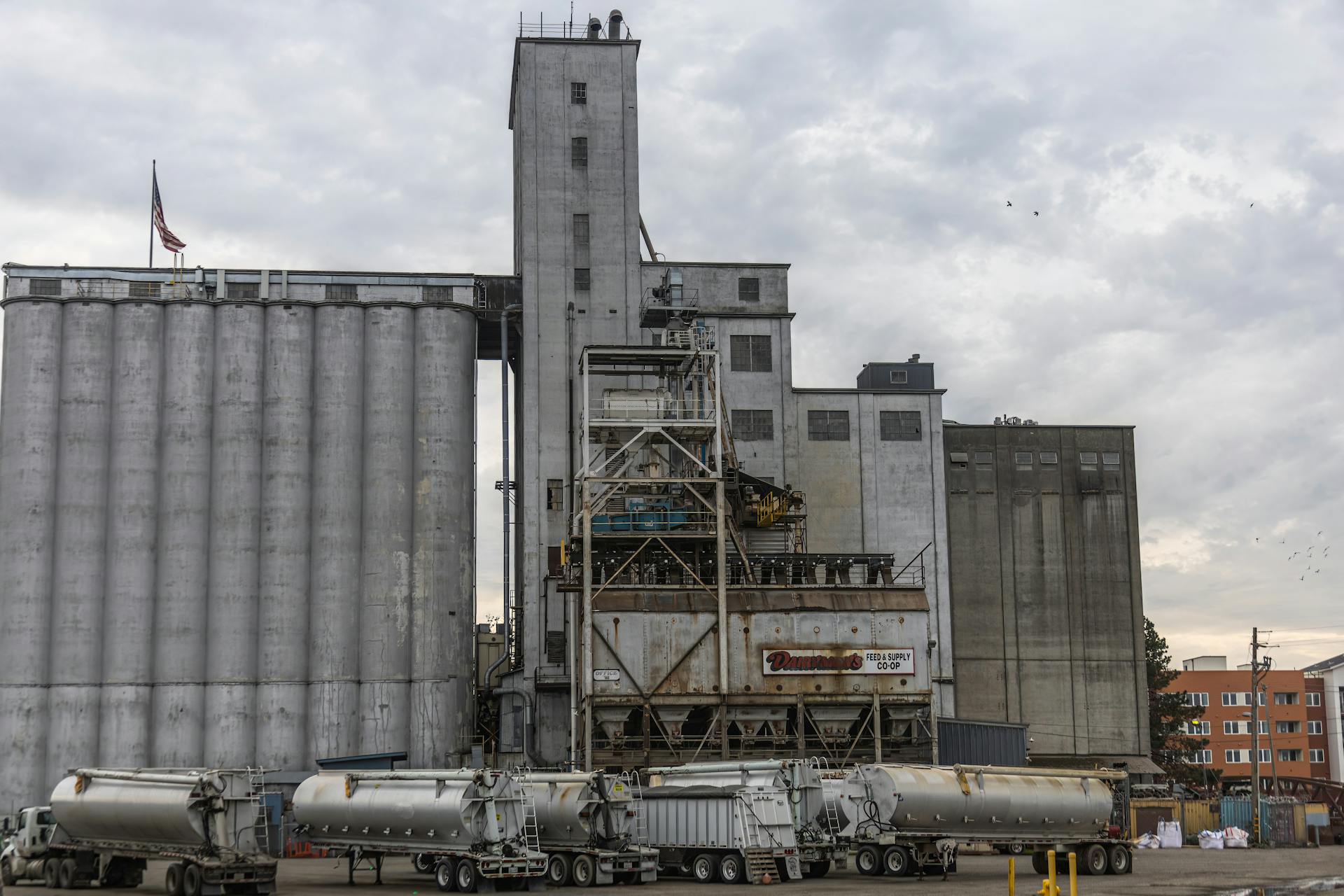
Depository banks play a vital role in our financial lives, acting as intermediaries between savers and borrowers. They accept deposits from customers and use those funds to make loans and investments.
Depository banks are required to maintain a reserve requirement, which is the percentage of deposits that must be held in reserve and not lent out. This requirement is typically set by the central bank and helps to prevent bank runs.
By pooling deposits from many customers, depository banks can offer a wider range of financial services, including checking and savings accounts, credit cards, and loans. This makes it easier for individuals and businesses to manage their finances.
Depository banks also provide a safe and secure way to store money, as deposits are insured by the government up to a certain amount. This gives customers peace of mind and confidence in their banking relationships.
For your interest: Bank of America Issues Warning to Customers
What Is a Depository Bank?
A depository bank is a type of financial institution that allows consumers and businesses to deposit money, securities, and other valuable assets for safekeeping.
Depository banks provide a safe place to store physical assets, eliminating the owner's risk of holding them. They offer time deposit and demand deposit accounts, such as checking and savings accounts.
A depository bank's main source of funds is deposits from customers, making it a type of depository institution.
Related reading: Bofa Accounts Temporarily Unavailable
Types of Depositories

A depository bank's main source of funding is through deposits from customers, which are insured by the Federal Deposit Insurance Corporation (FDIC) up to certain limits.
There are three main types of depository institutions: credit unions, savings institutions, and commercial banks.
Credit unions are nonprofit companies that focus on customer services, allowing customers to make deposits into an account that's similar to buying shares in that credit union.
Their earnings are distributed in the form of dividends to every customer.
Savings institutions, also known as savings and loan institutions, are for-profit companies that focus primarily on consumer mortgage lending and may also offer credit cards and commercial loans.
They earn interest on these products, such as mortgage loans and credit cards, and use the deposits to fund them.
Commercial banks are the largest type of depository institutions and are for-profit companies that offer a range of services to consumers and businesses.
Discover more: Bank Services Billing Standard
They accept deposits and primarily use them to offer mortgage loans, commercial loans, and real estate loans.
Banks can pay a lower rate of interest on deposits because the funds they hold are guaranteed by the FDIC up to a certain limit.
The FDIC insurance limit varies, but it's a safety net for depositors.
What Is an Institution?
An institution is a financial organization that provides a safe place for people to store their money and valuable assets.
A depository institution, for example, is a financial institution whose main source of funds is deposits from customers.
Depository institutions, such as commercial banks, credit unions, and savings and loan associations, hold customers' money and pay interest on their deposits over time.
These institutions accept customers' money and lend it to others in the form of mortgage or business loans, generating more interest on the money loaned than the interest they paid to customers.
Bank deposits, on the other hand, consist of money placed into banking institutions for safekeeping.
Customers have the right to withdraw deposited funds, as set forth in the terms and conditions governing the account agreement.
Curious to learn more? Check out: Bank of America Paying Customers
Bank Assets and Liabilities
A bank's assets and liabilities are like two sides of the same coin. A bank's assets are what it owns or has control over, while its liabilities are what it owes to others.
Most of a bank's assets are loans and securities, which are the main sources of income for a bank. Banks try to minimize the cash they hold because it earns no interest.
Loans are the biggest assets of banks, and they can be categorized into several types, including commercial and industrial loans, real estate loans, consumer loans, and interbank loans.
Here are some common types of loans:
- Commercial and industrial loans (C&I), which are business loans
- Real estate loans
- Consumer loans
- Interbank loans
- Other types
A bank's liabilities, on the other hand, are what it owes to its customers, and deposits are the largest percentage of a bank's liabilities. Deposits are considered a liability because it is money that is owed to its customers.
Repository Example
Euroclear is a great example of a clearinghouse that acts as a central securities depository for its clients. It settles domestic and international securities transactions, covering bonds, equities, derivatives, and investment funds.

Most of its clients are banks, broker-dealers, and other institutions that trade on European exchanges. They manage new issues of securities, market-make, trade, or hold a wide variety of securities.
Domestic securities from more than 40 markets are accepted in the system, covering a broad range of internationally traded fixed- and floating-rate debt instruments. This includes domestic debt instruments, short- and medium-term instruments, equities and equity-linked instruments.
International bonds from major markets like Europe, Asia-Pacific, Africa, and the Americas are also part of the system.
A unique perspective: Debt and Finance Advising
Bank Assets — Uses
Banks hold a variety of assets, which can be grouped into four main categories: cash, securities, loans, and other assets.
Cash is an essential asset for banks, but it's also an expensive one, as it earns no interest and takes up space in vaults or ATM machines. Banks try to minimize the cash they hold, keeping only what's necessary to meet withdrawal requests and conduct business.
Here's an interesting read: How Much Money Is an Atm

Banks also hold securities, such as bonds, to earn additional returns. In the US, banks are restricted to owning bonds, mostly Treasuries or municipal bonds, although they also held mortgage-backed securities, which contributed to the 2008-2009 Great Recession.
Loans are the biggest assets of banks, making up a significant portion of their portfolios. Commercial banks specialize in loans to businesses, saving and loans specialize in mortgages, and credit unions specialize in consumer loans.
Loans are categorized into several types, including commercial and industrial loans, real estate loans, consumer loans, interbank loans, and other types. This diversification allows banks to spread their risk and earn returns from different sources.
Here's a breakdown of the main categories of bank assets:
- Cash: an essential asset for banks, but also an expensive one
- Securities: bonds, such as Treasuries or municipal bonds
- Loans: the biggest assets of banks, categorized into several types
- Other assets: real property, equipment, and repossessed collateral
Liabilities: Sources of Funds
Banks have two main sources of funds: deposits and borrowings, with deposits being the larger percentage of a bank's liabilities. Deposits are considered a liability because they are money that is owed to the bank's customers.

Deposits are money that customers place in the bank for safekeeping, to provide payment services, and to earn interest. This can be classified as either checkable deposits or nontransaction deposits.
Checkable deposits allow customers to write checks or use their debit cards, while nontransaction deposits, such as savings accounts, are not intended for frequent use.
Deposits are the larger percentage of a bank's liabilities, making up the majority of a bank's funds.
Borrowings
Banks borrow in the interbank market, called the federal funds market, where they lend and borrow money held in their accounts at the Federal Reserve, known as federal funds.
Smaller banks often have excess reserves to lend to larger banks in major metropolitan areas that need to borrow.
Banks can borrow directly from the Federal Reserve through its discount window, but this is usually a last resort.
This indicates to the Federal Reserve that the bank is under financial stress, making it a sign of trouble.
Recommended read: How to Get a Navy Federal Credit Union Account

Banks can also borrow short-term through repurchase agreements, also known as repos, which involve exchanging securities for funds, usually for a term of 1 day.
Most repos are with corporations or financial intermediaries, such as pension funds or insurance companies, that have a temporary surplus of cash.
The Federal Reserve uses repurchase agreements to control the money supply by buying or selling Treasuries.
Discover more: I M B Bank Share Price Today
Types of Bank Accounts
You can open various types of bank accounts, each with its own benefits and requirements. Checking and savings accounts are two common types of accounts.
The Federal Deposit Insurance Corporation (FDIC) insures all types of deposits, including checking and savings accounts, up to $250,000 per depositor, per insured depository institution.
When you open a checking account, you have specific rights, including the right to dispute unauthorized transactions.
You can also open a savings account, which is an investment vehicle for consumers.
Time deposit accounts, also known as certificates of deposit (CDs), offer a higher rate of return than traditional savings accounts, but you must leave the money in the account for a set period of time.
Expand your knowledge: Bet 365 Online Banking Withdrawal Time

You can receive information about fees, interest rates, and other terms for deposit accounts under the Truth in Savings Act (TISA).
Here are some examples of when you're entitled to receive this information:
- when you open an account,
- upon request,
- when the terms of your account are changed,
- when a periodic statement is sent, and
- for most time accounts, before the account matures.
Bank Services and Operations
A depository bank provides safekeeping for assets, cash, and valuables, eliminating the risk of theft and loss.
They pay interest on your deposits, which will grow your balance over time.
Depositories create liquidity by lending out money, making it easier to access funds when you need them.
Electronic Fund Transfers
Electronic fund transfers, also known as EFTs, are a convenient way to manage your finances. They instruct a financial institution to either credit or debit your account electronically.
Examples of EFTs include ATM transactions, direct payroll deposits, and online banking. To protect your rights in these transactions, the Electronic Fund Transfer Act (EFTA) has established certain guidelines.
Here are some key restrictions and requirements imposed by the EFTA:
- Unsolicited issuance of ATM cards is restricted.
- Institutions must inform you about EFT service terms and conditions.
- Receipts and/or account statements must be documented for EFTs.
- Your liability for unauthorized transfers is limited.
- Procedures to resolve errors are established.
With EFTs, you'll want to keep an eye out for these standardized hold periods on deposits, which are required by the Expedited Funds Availability Act.
Expedited Funds Show

The Expedited Funds Availability Act requires banks to use a standardized hold period on deposits and to let you know when funds from deposits will be available. This information is usually posted in the customer service area.
Banks have to follow a specific timeline for making deposited funds available. According to the Expedited Funds Availability Act, banks must make deposited funds available to customers within a certain timeframe. This timeframe varies depending on the type of deposit and the bank's policies.
For example, the Act requires banks to make cash deposits available within 1 business day, and most banks follow this rule. However, some types of deposits may be held for longer periods, such as checks and wire transfers.
Here's a breakdown of the typical hold periods for different types of deposits:
- Cash deposits: 1 business day
- Check deposits: 2-5 business days
- Wire transfers: 1-2 business days
Keep in mind that these are general guidelines, and the actual hold period may vary depending on the bank and the type of deposit. It's always a good idea to check with your bank to confirm their specific policies and procedures.
Bank Regulations and Requirements

The Board of Governors of the Federal Reserve System requires depository institutions to hold a certain amount of funds in reserve against their customers' deposits. This is known as reserve requirements.
The goal of this requirement is to maintain a healthy economy with maximum employment and stable prices and interest rates. The Federal Reserve uses reserve requirements as one of the tools of monetary policy to manage the supply, availability, and cost of money.
Banks are also required to use a standardized hold period on deposits, which means they'll let you know when funds from deposits will be available. This information is often posted in the customer service area.
Related reading: Reserve Requirements Definition
Understanding Regulation CC
Regulation CC, also known as the Expedited Funds Availability Act, requires banks to make funds from deposits available to consumers in a timely manner. This regulation is crucial for consumers to understand, especially when depositing items other than cash.
Under Regulation CC, banks must make funds from official instruments, such as checks, available on the next business day. This means that if you deposit a check, the bank must make those funds available to you by the next business day.
You might enjoy: Ach Debit for Consumers
The clearing process for checks takes approximately 10 days, involving several steps, including the depositary bank sending the check for collection and the paying bank sending payment if the check is good.
Here's a breakdown of the clearing process:
- The payee deposits the check.
- The depositary bank sends the check for collection.
- The check is sent from the depositary bank to the Federal Reserve Bank or clearinghouse and then to the paying bank (drawee).
- The check is presented to the paying bank for payment.
- If the check is good, the paying bank sends payment (collected funds); however, if the check is bad, the paying bank returns the item as unpaid (uncollected funds).
- If the item is returned as unpaid, the depositary bank then debits the payee's account for the amount of uncollected funds.
Banks are also required to inform consumers when funds from deposits will be available, often posting this information in the customer service area.
Qualified
Qualified depositories are financial institutions that meet specific requirements set by regulatory bodies. These institutions are listed on the Federal Reserve's website.
Some examples of qualified depositories include America First Credit Union, Ascent Credit Union, and Bank of Utah. These institutions have been vetted and meet the necessary standards.
In fact, there are over 30 qualified depositories listed on the Federal Reserve's website. Here is a list of some of the qualified depositories mentioned in the article:
- America First Credit Union
- Ascent Credit Union
- BMO Harris Bank NA dba Bank of the West
- Bank of Utah
- Brighton Bank
- Cache Valley Bank
- Capital Community Bank
- Central Bank
- Chartway Federal Credit Union
- Continental Bank
- Cyprus Credit Union
- DesertView Federal Credit Union
- Desert Rivers Credit Union
- DL Evans Bank
- Eastern Utah Community Credit Union
- Education First Credit Union
- First Utah Bank
- Fortis Private Bank
- Glacier Bank dba First Community Bank, Alta Bank
- Goldenwest Federal Credit Union
- Grand Valley Bank
- Granite Credit Union
- Green Dot Bank dba Bonneville Bank
- Holladay Bank & Trust
- Home Savings Bank
- Jordan Federal Credit Union
- JP Morgan Chase Bank
- Key Bank NA
- Kings Peak Credit Union
- Mountain America Federal Credit Union
- NBH Bank
- Nebo Credit Union
- Prime Alliance Bank
- San Juan Credit Union
- Sunwest Bank
- State Bank of Southern Utah
- US Bank NA
- Utah Community Credit Union
- Utah First Federal Credit Union
- Utah Heritage Credit Union
- Utah Independent Bank
- Wasatch Peaks Credit Union
- Washington Federal Bank NA
- Web Bank
- Wells Fargo Bank NA
- Zions First National Bank
Bank Reporting and Taxes
Banks report check deposits to the IRS if the amount is over $10,000.
This means that if you deposit a large sum of money, the bank will notify the IRS. Bank deposits are a common way for people to store their money, and they offer a safe and convenient way to access your funds at any time.
Banks are legally required to report deposits over $10,000, regardless of whether it's a check or cash.
Understanding Bank Deposits
Bank deposits are essentially a liability owed by the bank to the depositor. This means that when you deposit money into a bank, you're essentially lending it to the bank, and they're obligated to return it to you whenever you want.
The types of bank deposits include checkable deposits, nontransaction deposits, and time deposits. Checkable deposits are used for everyday transactions, while nontransaction deposits earn interest but have limited withdrawal options. Time deposits, like certificates of deposit, have a fixed term and earn interest, but come with penalties for early withdrawal.
The Federal Deposit Insurance Corporation (FDIC) insures all types of deposits up to $250,000 per depositor, per insured depository institution. This means your deposits are protected in case the bank fails.
Curious to learn more? Check out: List of Banks in Nigeria
Checkable and Nontransaction Deposits
Checkable deposits are deposits placed in checking accounts that allow you to withdraw money at will, write checks, and transfer funds electronically. They provide safekeeping, accounting, and payment services, but pay little or no interest.
Checkable deposits have declined as a percentage of a bank's liability, from an average above 40% in the early 1970s to less than 10% today.
Nontransaction deposits, on the other hand, are deposits in savings and time deposit accounts where withdrawals are limited. This type of deposit is mainly beneficial for the interest it pays.
Banks can pay a lower rate of interest on deposits because the funds they hold are guaranteed by the Federal Deposit Insurance Corporation (FDIC) up to a certain limit.
Savings accounts allow you to withdraw funds at will, but if you make too many withdrawals within a month, the bank will charge a fee for withdrawals above the limit.
Certificates of deposit (CDs) have specified terms and face values equal to the amount deposited, and the withdrawal of funds is restricted until the CD matures.
Here's an interesting read: Fdic Insurance Business Accounts
How Bank Deposits
Bank deposits are a liability owed by the bank to the depositor.
When you make a cash deposit into a bank account, you surrender the legal title to the cash, and it becomes an asset of the bank.
The bank then holds this asset in a safe place, eliminating your risk of holding physical assets. This is one of the main purposes of bank deposits.
Bank deposits can be in the form of savings accounts, checking accounts, or money market accounts, as mentioned in Example 2.
The bank pays interest on your deposits over time, generating more interest on the money loaned than the interest they paid to customers.
Explore further: What Is Financial Asset Management Systems
Frequently Asked Questions
What is the difference between a drawee bank and a depository bank?
The drawee bank is the bank that pays the check, while the depository bank is the bank where the payee deposits the check. Understanding the roles of these two banks is essential for navigating check transactions smoothly.
What is the difference between a bank and a depository?
A bank account is for storing cash, while a depository holds securities like shares and bonds through a Demat account. This distinction helps you manage your finances and investments efficiently.
What is a depository bank name?
A depository bank name is the name of the bank that holds your checking and/or savings account. It's usually the name you see on your bank statements and checks.
Sources
- https://thismatter.com/money/banking/depository-institutions.htm
- https://www.investopedia.com/terms/d/depository.asp
- https://www.occ.treas.gov/topics/consumers-and-communities/consumer-protection/depository-services/index-depository-services.html
- https://treasurer.utah.gov/for-government/money-management-council/qualified-depository-list/
- https://www.investopedia.com/terms/b/bank-deposits.asp
Featured Images: pexels.com


